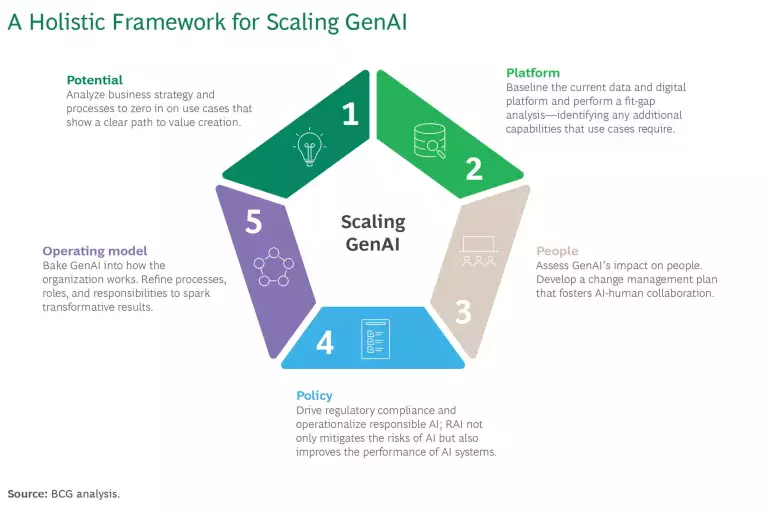As an engine for growth, generative AI offers remarkable horsepower: enough to drive a 1.8x margin impact , according to BCG analysis. Its might is particularly eye-catching in sales, where GenAI-created content promises new levels of precision, personalization, and efficiency. Account engagement, for instance, can be truly adaptive. Sales agents can instruct the GenAI, through natural language prompts, to produce plans and strategies, while a GenAI “assistant” generates call summaries, serves up next-best actions, creates follow-ups, and suggests new opportunities.
So how do we get to this future faster? It’s a question more companies are asking. Over 80% of enterprises expect to deploy generative AI by 2026, according to Gartner. Yet judging from the current landscape, deploying doesn’t necessarily mean scaling. BCG analysis reveals that only 10% of companies are scaling at least one GenAI application across the enterprise, roughly 50% of organizations are in the pilot stage, and about 40% have yet to take action.
Three factors are key to accelerating the generative AI journey: unlocking data and use cases, fostering adoption, and building trust. Checking these boxes can be a formidable challenge, even a roadblock for many organizations. But it doesn’t have to be. Companies can scale GenAI faster than they might think—and unleash its power throughout the full sales value chain.
Companies can scale GenAI faster than they might think—and unleash its power throughout the full sales value chain.
Across sales organizations, two key technology vendors are Amazon Web Services (AWS) and Salesforce. Both have added new capabilities—and crucially, integration with one another—that enable companies to use data, AI models, and other services in a seamless, cross-vendor way, with guardrails that create trust and conversational interfaces that spark adoption.
Getting the most out of this synergy requires a holistic approach. AI leaders focus on algorithms and the technology backbone but also relentlessly stress people and processes. So to help organizations accelerate their GenAI journey, BCG has developed a framework that builds the foundation for scaling AI. Organizations that follow it can optimize the AWS-Salesforce integration—and the value it can bring to the business and its people.
The Promise of Making All Data Accessible
In a 2023 global survey by AWS, 93% of responding chief data officers said that a sound data strategy is essential for GenAI value creation. Yet nearly half of the CDOs—46%—indicated that finding the right data quality and use cases remains a problem.
To work well in a business context, AI—whether generative AI or the more traditional, predictive AI, which forecasts trends and outcomes—needs access to relevant, high-quality enterprise data. The AI should be able to find any data in the organization (whether the source is CRM, ERP, or a data lake) and deliver precise insights and output. But pulling in a full set of data is difficult when information is scattered across silos and systems.
Integration between Salesforce Data Cloud and AWS unifies business data. Whether that data resides within Salesforce or lives on AWS services like Amazon Redshift (a fully managed cloud data warehouse) and Amazon EMR (a cloud solution for large-scale data processing, interactive analytics, and machine learning), it is now equally accessible to the AI. For example, Amazon Q, a generative AI-powered assistant that can answer questions, provide summaries, generate content, and perform tasks based on enterprise data, can leverage data from across Salesforce and AWS, respecting the access permissions a company has set. The result is a more informed AI producing more precise—and more impactful—output.
Making all data accessible also helps meet an increasingly common expectation: the availability of turnkey AI use cases at the beginning of the AI journey. Amazon Q Business, for instance, enables data from any unstructured source to be automatically indexed and available as an out-of-the-box chatbot.
Turnkey use cases can go beyond task-level automation, powering key sales processes. Consider client meeting prep for financial services. Traditionally, this process involves a series of labor-intensive steps, each requiring access to specific data sources: schedule an appointment with the client, summarize the client’s financial accounts, generate the client’s financial plan and goals, sum up previous interactions, create a holistic client profile summary, and recommend actions. Now, a sales agent working in Salesforce can trigger the full process through a natural language prompt, along the lines of “What should I know about John Smith before we meet?” With the AI tracking down data and generating content, the sales agent not only prepares faster but spends less time on leg work, freeing up time for other activities.
Promoting Adoption and Trust
AI revolutionizes sales by augmenting and accelerating human capabilities. But human-centered design is as much about adoption as features. Systems need to be both useful and usable . In the AI landscape, that hasn’t always happened. According to a 2024 global study by BCG X , the top three challenges frontline workers reported with generative AI were insufficient time to learn to use the tool, ineffective training, and uncertainty about when to use GenAI.
A key enabler in fostering adoption is GenAI’s ability to power conversational interfaces and assistants, like Amazon Q, where users interact with the AI in real time, in natural language. Salesforce implements this functionality through its Einstein Copilot—in effect an AI sales assistant. Through natural language prompts, sales agents can ask questions of the AI or instruct it to generate content.
AI revolutionizes sales by augmenting and accelerating human capabilities. But human-centered design is as much about adoption as features.
Integration between Salesforce and AWS means that Salesforce users can create custom prompt templates grounded in their data and send those prompt templates to foundational models—the large language models (LLMs) that are the core of GenAI—hosted on Amazon Bedrock. They can also utilize predictive AI models in Amazon SageMaker within the Salesforce platform. In effect, companies can now use the models that best suit their needs, fuel them with unified data, and wrap them in a natural language conversational interface.
And they can do this while building trust. AWS fosters the responsible use of AI through Amazon Bedrock Guardrails, model evaluation capabilities in Amazon Bedrock and SageMaker, and other services and features. Also, AWS data and LLMs are available through Salesforce’s Einstein Trust Layer—a secure AI architecture built into the Salesforce platform—to power Salesforce workflows. These features, which include data masking and zero data retention, ensure that an LLM won’t retain or subsequently use a prompt or the output it triggers. This reduces or eliminates many of the key concerns about how LLMs might use a company’s sensitive data, such as personally identifiable information, proprietary data, or intellectual property.
Subscribe to our Marketing and Sales E-Alert.
Integration in Action
AWS is leveraging the integration of data and LLMs to drive sales effectiveness in its own operations. AI—powered by models from Amazon Bedrock (to build and scale GenAI applications with foundational models) and Amazon SageMaker (a fully managed infrastructure to build, train, and deploy FMs)—generates account summaries for sales teams, enabling them to more quickly plan for customer meetings and more precisely tailor solutions and identify cross-selling and up-selling opportunities. The AI synthesizes an array of internal and external data sources (including CRM, usage, market research, web search, financial filings, and breaking news) into a consumable narrative of a customer’s needs, challenges, and growth potential. It also provides actionable recommendations and ML insights enabled by Amazon SageMaker. Account teams using the summaries have been able to shave, on average, 35 minutes off customer meeting prep and generate 4.9% higher pipeline value.
Bringing It All Together
AI leaders—organizations that have moved beyond pilots to unleash AI at scale—may come from different sectors, work in different environments, take different AI journeys, but they tend to share one trait: they fuse cutting-edge technology with business strategy and enablement. BCG experts refer to it as the 10-20-70 rule : companies that win with AI typically dedicate 10% of their effort to algorithms, 20% to data and the technology backbone, and 70% to business and people transformation.

That rule is at the core of BCG’s framework for driving AI at scale. (See the exhibit). Built around five pillars, the framework can be used to accelerate the GenAI revolution in sales—and maximize the impact of AWS-Salesforce integration.
Find the Potential That Matters Most
With all the ways to use GenAI, the key is knowing where to focus and how to prioritize initiatives. Yet we find that most organizations have a fuzzy view of where the value lies with generative AI. They start their journey with no agreed-upon value target, no business case for leveraging GenAI across their sales processes.
BCG’s approach is to align GenAI solutions with business strategy, focusing on use cases that provide a clear route to value generation. This means looking closely at processes and identifying the pain points that generative AI can alleviate, the ways it can help people devote more time to customer interactions and other value-creating work, and how the technology can drive efficiency, speed, and better experiences. This analysis lets us quantify the link between GenAI initiatives and value, focus where that connection is strongest, and develop a roadmap (factoring in any existing AI strategy, to avoid misaligned parallel activities).
Perfect a Data and Digital Platform
A modular IT infrastructure, data pipelines, and robust data management practices are critical for generative AI. As a starting step, BCG baselines an organization’s existing architecture and, looking at the set of use cases, performs a fit-gap analysis. This lets us zero in on the capabilities a company needs to build to implement and scale those use cases.
Transformations are most likely to succeed when they create value early, sparking support—and momentum—for the longer journey. So as companies make their first foray into GenAI, we recommend that they focus on quick wins: use cases that organizations can implement fast but that visibly generate value. This approach lets companies build their capabilities steadily, in optimal order. They develop what they need for a specific use case and, with each new use case, build out their capabilities. As an organization’s data and AI maturity grow, so does its ability to deploy ambitious, innovative GenAI solutions.
Data management and governance can be particularly challenging for generative AI. LLMs typically train on unstructured data—think documents, images, audio, even programming code—and organizations don’t tend to have much experience labeling and managing these types of data. The result: they lack a deep understanding of how they can and can’t use the data. BCG helps establish processes that create and apply this insight, reducing risk by fostering appropriate and responsible use of data. To that end, an exciting development is the use of GenAI itself to solve GenAI’s data management problem .
Enable and Empower People
By augmenting human capabilities, generative AI brings out the best in an organization’s people. But change, as adoption challenges have shown, is never easy. It’s crucial, then, to assess GenAI’s impact on employees and develop a robust change management plan. This includes creating a culture that fosters AI-human collaboration. Quick wins that demonstrate the power of AI to augment, not replace, a workforce go a long way here. So does leadership that drives—and even evangelizes—change.
In addition, BCG experts recommend some specific steps:
- Assess skill gaps and reskill people accordingly.
- Prioritize continual training—GenAI is evolving—and carve out protected time for people to learn and adapt to the technology.
- Communicate how generative AI can create value and remove the toil from work.
- Anticipate the evolution of roles and skills as GenAI transforms the sales function.
Another best practice is to embrace no-code or low-code tools, such as PartyRock by AWS or Amazon Q Apps. This does double duty. It boosts the efficiency of skilled programmers, allowing them to devote greater time to more value-adding work. But it also lowers the technical threshold, so those without programming experience, such as business analysts, can more readily use AI tools or even create their own solutions. Amazon employees, for example, have created more than 24,000 apps for internal use cases. One example: a note taker that summarizes meetings and documents action items.
Create Policies for Compliance and Responsible AI
AI leaders build trust by aligning generative AI use cases with regulations and standards. They define and communicate internal GenAI guidelines and procedures. And crucially, they develop and operationalize responsible AI (RAI) : the process of designing, developing, and operating AI systems that align with organizational purpose and values. RAI is not a one-and-done process but an ongoing initiative—one that needs to evolve in step with technology and societal attitudes. It’s also not a process that should fly under the radar. By communicating, even evangelizing, the importance of RAI, organizations get the word out that AI use cases must—and can—be built and applied responsibly.
Companies that implement RAI strategically often find that it minimizes the risks of AI but, at the same time, boosts the performance of AI systems . BCG experts draw on proprietary tools for implementing a custom-fit framework for RAI. Chief among them is the RAI Maturity Assessment, which benchmarks across the central components of RAI maturity: RAI strategy, AI governance, key processes, technology and tools, and culture. By shedding light on strengths and gaps, the assessment reveals areas for focus.
Optimize the Operating Model
Generative AI becomes truly transformative when companies bake it into how they work—when they can generate deeper, faster, better insights and immediately act on them to drive business outcomes. Accelerating the GenAI revolution in sales means rethinking, and redesigning, end-to-end processes and refining the organizational structure as roles and responsibilities evolve.
It also requires executional certainty. BCG assists companies in setting up a central team for GenAI coordination and delivery squads for building use cases. We help define KPIs to measure progress and key outcomes to ensure that organizations are achieving their business objectives.
To seize the full power of GenAI and spark a true revolution across the sales value chain, organizations need to make all data accessible, foster adoption of GenAI solutions, and build trust into their AI-powered processes. By leveraging BCG’s AI and Salesforce Value Accelerator capabilities in partnership with Salesforce Professional Services product expertise, the power and goals of the new integrations between AWS and Salesforce are more achievable than ever before. When all the pieces come together—strategy, use cases, technology, people, and processes—GenAI creates something more than content. It creates growth.
The authors thank Charlie Gair, David Affentranger, and Eugenia Guardia for their contributions to this article.
This article was a collaboration among BCG, Amazon Web Services, and Salesforce.
Amazon Web Services
Salesforce
Salesforce brings together all your data, from any source. Salesforce AI solutions for technology unlock growth and productivity powered by the #1 AI CRM. Diversify and protect your revenue, transform customer engagement with unified data, and boost productivity across teams with AI-powered insights and actions.















